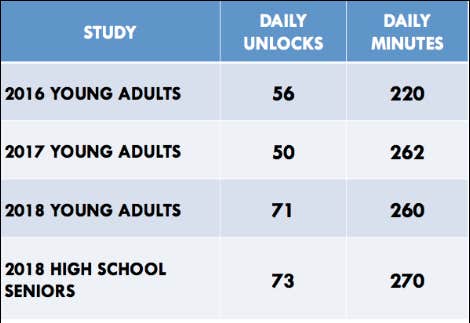The Psychological Reason You Can't Stop Checking Your Phone
Is it addiction or obsession? An expert weighs in.
 Getty Images
Getty Images A J2015 Gallup poll of 15,747 adult smartphone users found that half check their phone a few times an hour (41 percent) or every few minutes (11 percent).
When they examined 18-to 29-year-old smartphone owners, those figures increased to 51 percent checking a few times an hour and 22 percent checking every few minutes.
More recent work from my lab has used an unobtrusive app that tracked how often young adults and teenagers unlocked their phones and how many minutes a day they remained unlocked.
The data are in the table below where several issues are clear.

First, daily minutes jumped in the year between 2016 and 2017 likely due to the explosion of two social media sites: Instagram and Snapchat (the top two most often visited sites among our young adult and teenage participants).
Second, the number of daily minutes appears to have leveled off at more than four hours per day for young adults. The single high-school sample showed four and a half hours per day.
Third, daily unlocks seem to be rising rapidly and, to me, this trend is troubling.
While the math shows that in 2017, young adults were spending about 5.25 minutes per unlock, the 2018 data for both high school and young adults hover around 3.67 minutes per unlock.
More on this later, but it's important to recognize that teens and young adults are checking in way more often and for far less time.
By the way, if you own an iPhone using iOS12 or higher you now have an app called “Screen Time” which gives you daily and weekly reports on unlocks, minutes and much more, including how you spend those minutes and what apps are sending you notifications.
Paying attention to the rich data from these apps will, I believe, start you on your way to a healthier relationship with your smartphone.
With teens and young adults (and really adults of all ages) pointing their faces down at their smartphone screens, it is a hardly surprising observation that we are all ignoring the people and obligations (work, school, parenting) directly in front of us.
I have been studying the psychological impact of technology and how it's changed our lives for more than three decades, well before the proliferation of laptop computers, smartphones, social media, and our need for constant connection.
As an observer of people, I have seen technology trends come and go. Until recently, those trends seemed to take many years to rise to prominence and — if not adopted by enough people — eventually fade in importance.
Most likely this slow pendulum swing stemmed from the fact that earlier technologies took a substantial time to be used by enough people to cause others to feel a need or desire to partake.
Consumer scientists refer to this process as “penetration rate,” and have always used as a benchmark the idea that a product has penetrated society when 50 million people are using it.
Before the Internet, technology penetration rate referred to physical products such as radio (which took 38 years to hit 50 million), telephones (20 years), and television (13).
But the World Wide Web took a mere 4 years to penetrate society, as did instant messaging and iPods.
Social media further changed the game: MySpace took two-and-a-half years to hit the mark, Facebook only two, and YouTube just one.
Newer websites and games emerged and swept through society in months, not years.
Angry Birds hit the mark in 35 days; Instagram, Snapchat, and Minecraft each took just a few months.
Pokemon Go took only 7 days to reach 50 million users! Each new iteration of the iPhone reaches 50 million as fast as they can churn them out.
That pendulum is now swinging wildly, though, and we have seen products such as Google Glass hit, gain traction, and disappear in what seems like the blink of an eye, while others, such as Snapchat, just keep gaining momentum.
I have written often of the issues involved in this process and have spoken about our addiction to, and obsession with, technology.
After writing seven books and numerous journal articles based on laboratory, survey, neuroscience and observational research, I think I have finally arrived at an understanding of the processes that underlie our seeming inability to put down our devices:
It all comes down to what is happening in our brains and in our minds.
When you glance at your phone, in the absence of an alert or notification, how do you feel?
I would bet that sometimes you feel happy, like when you read something on Facebook that makes you smile, or watch a video that you then forward to your friends.
But I'd also bet that sometimes you feel relief — that you have not missed out on something someone posted or said (FOMO); that nobody is having fun without you; or even that you are among the first to like or comment on a post.
These are two different processes: When you do an activity and subsequently feel pleasure or satisfaction, and the desire to do that same action again in order to gain the feeling, then it is most likely symptoms of a possible addiction.
If, however, you do an activity and feel a sense of relief that you did not miss out on something “everyone’s talking about,” or that you are the first to do something, then this is most likely a sign of a potential obsession.
An obsession is not built around the brain chemistry that produces the equivalent physical feelings of pleasure.
It is built around performing an act that reduces your feelings of anxiety and the chemicals that make you feel that way.
A third option that has been seen in recent research literature is that when we are in public, we use our phones as a shield against having to interact with the real people around us.
This may qualify as a form of social phobia or social anxiety, although the research is still divided.
When you are standing in line at the supermarket, do you grab your phone to avoid talking to the people in line as we might have done just a few years ago? If so, it is likely that you may have a dash of social phobia, another anxiety-based disorder.
On the other hand, a fourth option is that you may just be bored due to the constant stimulation obtained from your phone, as compared to the lack of stimulation from simply standing in line.
I believe that if you dig down in your gut and ask yourself why you are looking at your phone, you will discover that your motivation for constant connection is a combination of pleasure and anxiety with maybe a dash of social anxiety and boredom. How much of each, I believe, is based on the individual at given times.
Personally, I would say that during my workday I grab the phone about 75 percent of the time for anxiety reduction and 25 percent of the time for pleasure (I am rarely bored and almost never feel anxious in social situations).
In the evening, that ratio is reversed. I watch others and when I see some smiling as they tap keys and await return missives, I assume that they are feeling pleasure. Most often, I don’t see them smile at all, but maybe express an almost a visible sigh of relief.
How about you? When you grab your phone without an alert or notification, ask yourself why you are doing this and try to figure out whether it is to gain pleasure, reduce anxiety of not wanting to miss out, reduce social anxiety or you are just plain bored.
Regardless, the data shows that we are grabbing the phone so often that many of us are missing out on the life that is playing out right in front of us.
Just look at people walking down the street, standing at a bar, sitting in a restaurant, or browsing in a bookstore.
I guarantee that young and old will have their phone firmly in their palms and continue to self-interrupt to tap some keys and read some words or view pictures or videos. Spend a day noting how often people check their phones while they are working, in meetings, in class, everywhere.
I have written often about options to curb addiction or obsession. In an article titled "Here’s [Not] Looking At You!", I talked about ways to increase our eye contact (and fight our incipient social phobia) and gain a better understanding of other people’s emotional context.
In each of the posts on my blog, you can find specific strategies for helping you regain your “Humanware” to replace your obsession or addiction with your hardware and software.
It's up to you as to if or when you choose to stop the pendulum swing and regain control.
Dr. Larry Rosen is Professor Emeritus, author of The Distracted Mind: Ancient Brains in a High-Tech World, and past chair of the psychology department at California State University, Dominguez Hills. He is a research psychologist with specialties in multitasking, social networking, generational differences, parenting, child and adolescent development, and neuropsychology, and is recognized as an international expert in the Psychology of Technology.
YourTango may earn an affiliate commission if you buy something through links featured in this article.

